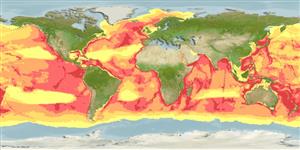Common names from other countries
Environment: milieu / climate zone / depth range / distribution range
Ecologia
Pelágico(a,os,as); não migratória (Ref. 75906); intervalo de profundidade 0 - 1989 m (Ref. 116169). Deep-water; 90°N - 90°S, 180°W - 180°E
Atlantic Ocean and Indo-Pacific. Tropical to warm temperate zones.
Length at first maturity / Tamanho / Peso / Idade
Maturity: Lm ?, range 270 - 280 cm Max length : 340 cm TL macho/indeterminado; (Ref. 1394); Peso máx. publicado: 400.0 kg (Ref. 1394)
Commonly seen over and near the continental slope. Feeds on deep-water cephalopods, fish and shrimps (Ref. 936).
Tan, J.M.L. 1995. (Ref. 936)
Status na Lista Vermelha da IUCN (Ref. 130435)
Status no CITES (Ref. 108899)
Not Evaluated
Uso pelos humanos
Pescarias: espécies comerciais
FAO - pescarias: landings, perfil da espécie | FishSource | Sea Around Us
Ferramentas
Mais informação
Idade/TamanhoCrescimentoComprimento-pesoComprimento-comprimentoMorfologiaLarvasAbundância
Fontes da internet
Estimates based on models
Preferred temperature
(Ref.
115969): 2 - 13.7, mean 4.5 (based on 2235 cells).
Vulnerabilidade
Very high vulnerability (90 of 100).
Categoria de preço
Unknown.
